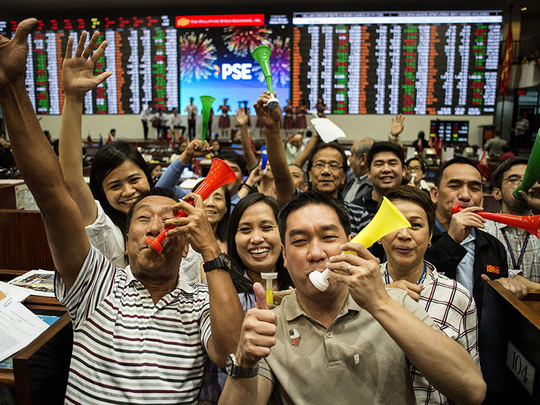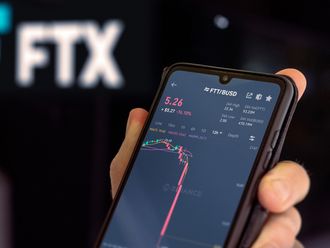
LONDON/SYDNEY: Markets were ending 2017 in a party mood on Friday after a year in which a concerted pick-up in global growth boosted corporate profits and commodity prices, while benign inflation kept central banks from snatching away the monetary punch bowl.
MSCI’s world equity index, which tracks 47 countries, inched up 0.15 per cent as six straight weeks and now 13 straight months of gains left it at yet another all time high.
The index has been on an upward trajectory for pretty much all of 2017, putting it 22 per cent and almost $9 trillion (Dh33 trillion) higher for the year.
Emerging markets have led the charge with gains of 34 per cent. Hong Kong surged 36 per cent, South Korea notched up 22 per cent and India and Poland both made 27 per cent in local currency terms.
Japan’s Nikkei and the S&P 500 are both ahead by almost 20 per cent, while the Dow has risen by a quarter. In Europe, the German DAX has gained nearly 14 per cent, though the UK FTSE has lagged a little with a rise of 7 per cent.
Craig James, chief economist at fund manager CommSec, said of the 73 bourses it tracks globally, all but nine have recorded gains in local currency terms this year.
“For the outlook, the key issue is whether the low growth rates of prices and wages will continue, thus prompting central banks to remain on the monetary policy sidelines,” said James.
“Globalisation and technological change have been influential in keeping inflation low. In short, consumers can buy goods whenever they want and wherever they are.” Yet there are reasons to suspect that times this good cannot last.
An index from State Street that gauges investor risk appetite by what they actually buy and sell, suffered its six straight monthly fall in December.
“While the broader economic outlook appears increasingly rosy, as captured by measures of consumer and business confidence, the more cautious nature of investors hints at a concern that markets may have already discounted much of the good news,” said Michael Metcalfe, State Street’s head of global macro strategy.
One of the early issues for next year will be an Italian election scheduled for March 4. As things currently stand the vote is expected to produce a hung parliament that could ultimately catapult the 81-year-old, four-times premier Silvio Berlusconi back to centre stage.
Italian government bond yields — which move inverse to price — rose to fresh two-month highs on Friday at 1.978 per cent. They started the year at just over 1.8 per cent but are still well under the highs of 2.5 per cent hit back in March.
DOLLAR DISAPPOINTS
US dollar bulls have not been nearly so fortunate this year. The widely held assumption at the start of the year was that, with the Federal Reserve set to raise interest rates further, the only way for the dollar was up.
Yet even though the Fed delivered on its three promised hikes, the currency has failed to benefit.
Measured against its major peers the dollar has shed more than 9 per cent so far this year, putting it on track for its biggest annual loss since 2003.
One winner has been the euro, which was near its highest in a month on Friday at $1.1944 and ahead almost 14 per cent for the year.
The dollar even backtracked on the yen despite the Bank of Japan staying doggedly committed to its super-easy monetary policy. As of Friday, the dollar was down 3.5 per cent for the year at 112.74 yen.
The dollar’s loss has been a boon for commodities priced in the currency, which have also benefited from a synchronised pick up in global trade and surprisingly strong demand from China.
Everything from coal to iron ore has reaped gains, with copper a stand-out performer in part due to expectations of rising demand for the mass production of electric vehicles.
The metal was near a four-year peak on Friday at $7,284 a tonne. It is up more than 30 per cent this year and on course for its largest annual rise since 2009.












